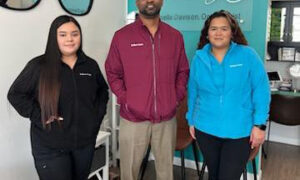By Lisa Shin, OD
Dec. 14, 2016
What would you do if your opticians resigned? Would you be able to train and instruct? Could you be the optician for a week? A few months ago, I had to do exactly that.
And jumping into the breach, as I was forced to do, taught me a great deal about how my office works. The experience also prompted me to develop more of a system for running it in the future.
The resignation of my two opticians was unexpected. One had been with me for nine years. This abrupt turnover in staff meant that I had to wear every hat in my practice. Feeling desperate, I hired in haste. I found two people with no optical experience or background. But I was impressed with their customer service skills, good-natured personalities, professionalism, and most importantly, their eagerness to learn new things.
Because of the timing, there was one week that I had to be both doctor and optician. It was daunting and overwhelming. But during this week, I formulated step-by-step guidelines, identified weaknesses, simplified procedures, discovered better ways of educating patients and spent hours in my own “optical boot camp.” My crash course included audio lectures, hands-on training and troubleshooting scenarios. Lab and vendor representatives came to the office to train my new staff, and introduced us to a wealth of resources.
You may never be forced to be the optician in your practice, but you must take charge in motivating optical staff to the next level. You must carefully inspect your optical, and constantly find areas for improvement.
Adopt New Technology: Digital Measuring Apps and iPads
Long-term employees are often the most loyal, knowledgeable and experienced. Over time, however, they can become entrenched in bad habits and resistant to changes.
I had purchased digital measuring apps, but I discovered that they were not being fully utilized. My opticians had resorted to the tried and true, pupillometer and marker, while the iPad collected dust. I had to become proficient with the app myself in order to teach it. With my new hires, I was relieved to store the pupillometer away! I wanted the highly accurate, precise and customized measurements for all orders from now on. This was essential for the highest-performance lenses on the market. Remember that online retailers cannot deliver this level of precision for PD and optical centers, not to mention the position of wear measurements: pantoscopic angle, vertex distance, and wrap angle. I taught my employees to include these measurements on both single-vision and multi-focal spectacle lenses.
With our app, I could review all of my opticians’ measurements and correct any mistakes. I could review the frame and lens choices on the saved record. I taught my staff to adjust the frame, and put pantoscopic tilt on it, before the image is taken. I figured out that the measurements were only as good as the image. If the patient was tilted slightly to the right or to the left, the measurements would not be accurate. I taught my employees to take multiple images, especially in the learning stage.
On sunwear with tinted demo lenses, the lenses must be removed to obtain accurate measurements. If this is difficult, the patient can shine a penlight behind the lens so that the pupil is visible. I discovered that this extra step was not being done, hence the high number of sunwear remakes.
“Your iPad will become your best friend,” was my opening statement to the new opticians on day one of their training. Indeed, iPads have many useful functions in today’s optometric office. They can be used for direct submission of orders, and can be integrated with an EHR system. We use the iPad for Amsler grid, color vision and visual acuity testing. Photos of patients wearing different frames can be e-mailed to friends and family. We also use apps that demonstrate lens options, such as polarization, free-form progressives, aspherics, anti-reflective coatings and blue light protection. We show patients YouTube videos that feature lens options and explain the importance of preventative care for common eye conditions.
Key to Success: Customized Progressives
As the optician I discovered another bad habit: A “one size fits all” approach to progressives. My opticians would refer to the same progressive for every patient, leading to a high number of progressive remakes. For my new staff, I have written detailed guidelines on choosing progressives based on a lifestyle questionnaire. Using variable and fixed-corridor designs is an excellent way to customize progressives. Short-corridor progressives work well for wraps, longer vertex distances and previous bifocal wearers. I start the conversation about the specific progressive that I recommend in my exam room.
Do a thorough inspection of your optical: What is missing?
Being forced to assume this role was the key to identifying problems and making necessary changes. I developed a better system for tracking credits on returned frames. My help sheets included verifying that we received second-pair, special-package pricing from the lab. I ordered new frame lines for a more robust safety and sunwear program. I saw that we needed a more inviting, fun selection for our kids and tweens. I filled in gaps we had in “special sizes,” such as for extra-large men and petite women. I also discovered that we were waiting on over $4,200 in payments for safety glasses. No one had bothered to follow through with the extra steps to get paid. I expanded and revised our special frame and lens package offerings. I tossed old catalogs, displays and materials. I simplified protocol to make things easier for my employees in training, as well as for my patients.
I trained my new employees to make appropriate frame recommendations based on patients’ pupillary distance, spectacle prescription, face shape and lifestyle. Another bad habit: Accepting the patient’s frame choice without question. I saw poor frame choices based on lifestyle and visual need, which led to redos, remakes and unhappy patients.
Start the Conversation in the Exam Room
Being the optician and training new staff meant that I had to make specific recommendations for every patient. I had to give detailed instructions, such as “These are the frames and lens options that I think will work best. Don’t forget you need a 30 B size for this occupational progressive, and discuss the working distance of their office.” I have found that patients are more likely to follow through when the message is from the doctor. I use myself as the example: “I love my free-form progressives. It makes a big difference in the quality of my vision over the older styles.” Or: “I’m on my digital devices from the time I wake up to the time I go to sleep. Honestly, I was skeptical about blue light’s impact on circadian rhythms, but I have less eye strain, and I am sleeping better with my BluTech lenses.”
I always talk about myself when making eyecare recommendations, including my severe dry eye and family history of macular degeneration. A conversation about eyewear in the exam room is a practice builder, as it conveys the message that we are the experts in both eyecare and eyewear.
Advantages of a Successful Optical: More Time with Patients
To have a successful optical, the doctor must be engaged, informed and involved. Many of us have opticians, who are self-motivated and always learning. However, even the most skilled opticians can become resistant to changes and new technologies. Bad habits not only have a negative impact on revenue, but also on patient satisfaction. Patients who are unhappy with their eyewear will go elsewhere, even if they received the best of care from you. It is easy to become complacent and passive.
I understand the new focus on the “medical model” for a successful practice. However, I have found that a thriving, profitable optical allows me to take better care of my patients. This revenue stream enables me to devote more time, care and attention to them. I am able to resist the “high volume,” quantity-over-quality trade-off. I am able to invest in the latest equipment for eyecare, such as my spectral domain OCT and fundus camera.
Today, I am happy to report that I have patients complimenting me on my new staff. We have increased the number of premium upgrades and decreased the number of remakes. My goal in the new year is to begin preparing my new opticians for the American Board of Opticianry (ABO) competency exam.
My week as an optician was disruptive and stressful, but it was exactly what I needed to super-charge my optical!
Have you done a thorough inspection of your optical? What areas need to be improved? What changes can you make today?
Lisa Shin, OD, is the owner of Los Alamos Family Eyecare, P.C. in Los Alamos, N.M. To contact: lshinrecall@gmail.com























